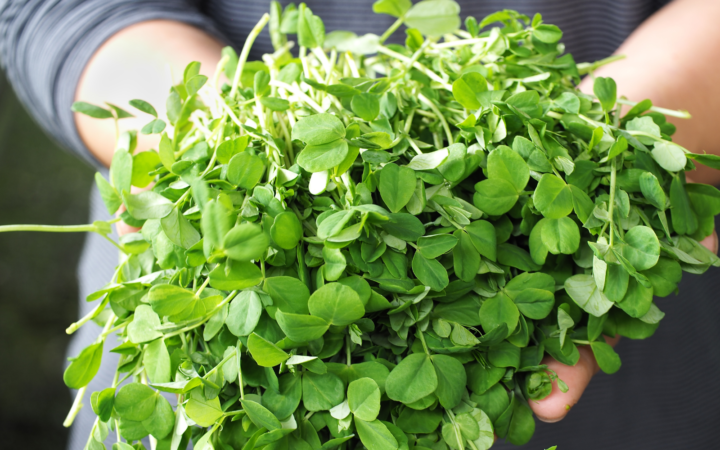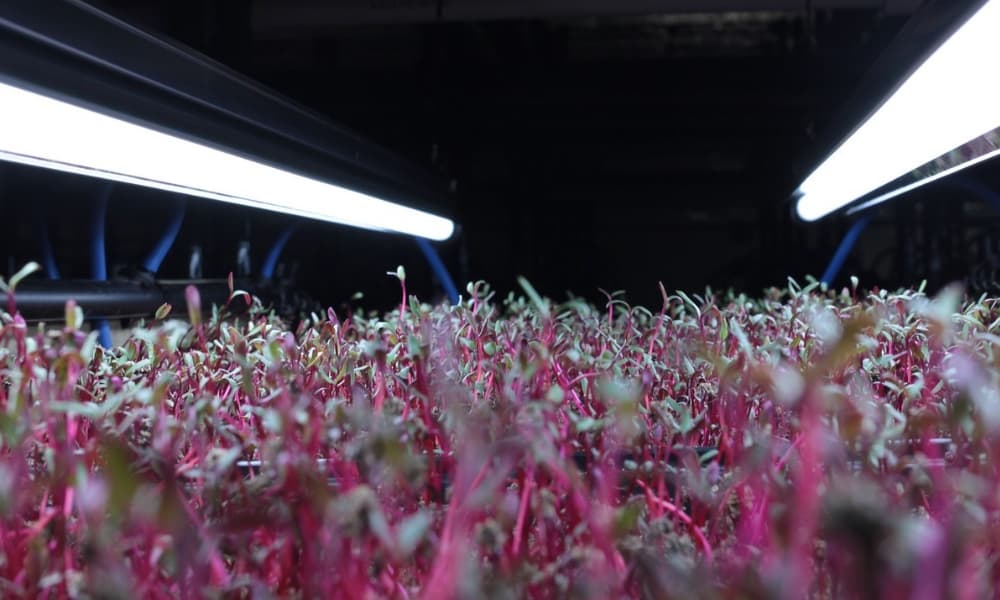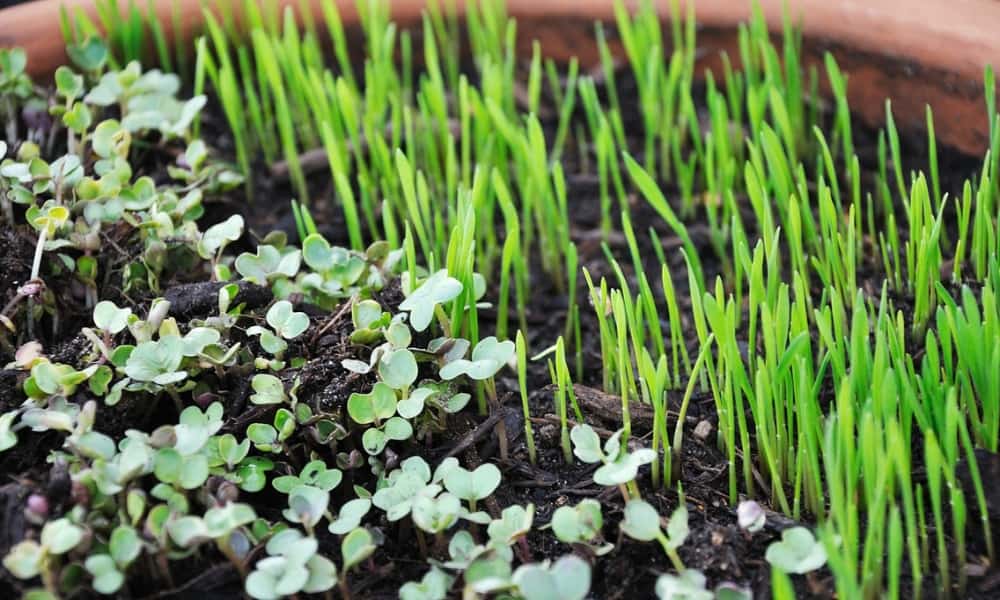Powerful Microgreens: Types, Health Benefits, And How To Grow

If there’s one food that proves big things come in small packages, it’s microgreens.
More than just the pretty little garnish you find on your food at fancy restaurants, these teeny-tiny versions of full-grown vegetables pack a nutritional punch (sometimes even more so than their bigger counterparts) and offer a host of health benefits.
Read on to learn about the different types of microgreens, what they can do for your health, and how you can grow your own tiny greens with virtually no effort at all.
What Are Microgreens?
Microgreens are edible young greens and grains that are produced from vegetables, herbs, or other plants such as arugula, beet, mustard, radish, red cabbage, and Swiss chard.
Also called baby plants, microgreens are slightly larger than sprouts (which don’t have leaves) but smaller than baby greens (baby spinach, baby kale, etc.).
Most microgreens measure about 1 to 3 inches in height, which includes the stem and leaves.
The reason they are so itty-bitty is because they’re harvested before they grow into a full-sized mature plant—usually around two weeks after the microgreen seeds have begun sprouting to the top of the soil.
In spite of (or really, because of) their small size, microgreens offer more concentrated and intense flavor—ranging from spicy to sweet—and potent nutritional value than their grown-up versions.

Best Types Of Microgreens
There are many varieties of microgreens that can be consumed before they ever become mature vegetables. Here are some of the best types of microgreens you might find at your local farmers’ markets or health food grocery store.
- Brassica: Broccoli, cabbage, mustard greens, arugula, mizuna, radish, watercress
- Daisy: Lettuce, endive, chicory, radicchio, sunflower
- Umbellifers: Parsley, dill, carrot, celery, cilantro, fennel
- Amaranth: Amaranth, chard, beetroot, spinach
- Gourds: Squash, pumpkin, melon, cucumber
- Allium: Garlic, chives, shallot, scallion, onion, leek
Brassica Microgreens
Better known as cruciferous vegetables, many brassica veggies can be grown as microgreens. These include red cabbage, purple kohlrabi, red and purple mustards, and mizuna.
Because they are rich sources of vitamin C, beta-carotene, and antioxidants including glucosinolates, polyphenols, and tocopherols (1), these vegetables have been shown to help prevent many ailments including heart disease and some types of cancers. (2)
A study published in 2014 showed that brassica microgreens tended to have more complex and varied polyphenols than those of their mature plant counterparts with a total of 165 phenolic compounds. (3)
Parsley Microgreens
Like the large and leafy full-grown plant, parsley microgreens boast a wide range of proven medicinal benefits. Although you might consider these teensy greens an afterthought to your main dish, don’t be so quick to push them aside.
Parsley greens are rich in many vitamins, especially vitamin K, which is needed for bone health as well as blood clotting. (4) Parsley also offers anti-inflammatory, brain protective, gastroprotective, anti-diabetic, antibacterial, and antifungal activities. (5)
Beet Microgreens
With their bright crimson-colored stems, beet microgreens are definitely a thing of beauty.
But more than just a sight to behold, these multi-colored minis have an impressive array of health benefits. Along with being rich in minerals like folate and manganese, beets can help regulate blood pressure (6) and even improve brain function thanks to its usage of nitrates. (7)
Of course, like all microgreens, beetroot is also high in antioxidants and anti-inflammatory properties. (7)
Chive Microgreens
Like its flavorful and spicy cousins—garlic, shallots, scallions, onions, leeks—chives are more than just tasty toppings.
They are nutrient powerhouses that have numerous anti-inflammatory and antioxidant properties as well as a good amount of vitamins.
One of the compounds found in chive microgreens is allicin, which helps decrease blood pressure, lower bad cholesterol, and improve heart health. (8) Chives also contain choline, which is essential for memory, mood, muscle control, and other brain and nervous system functions. (9)
Are Microgreens Safe To Eat?
Yes, microgreens are considered safe to eat.
Just remember they have a very short shelf life (10)—usually no more than five days, even when properly stored in a refrigerator.
In fact, a 2014 study showed that radish microgreens only had a shelf life of 1-2 days at ambient temperature with the optimal storage temperature being 1 degree Celsius or 33.8 degrees Fahrenheit. (11)
While it’s good to be cautious about potential bacterial contamination, it’s also worth noting that sprouts—not microgreens—are more likely to cause food poisoning.
That’s because sprouts are grown in humid conditions where bacteria can thrive. This is another reason why it’s so important to know where your food comes from, microgreens or not!

How To Grow Microgreens
If you’re not much of a green thumb, no worries. You can grow your own microgreens year round without much fuss or finesse. Thanks to their compact size, microgreens are quite easy to grow indoors or outside.
- To start, make sure you buy products from a reputable source and use organic ingredients whenever possible. This includes the potting soil and seeds.
- To grow microgreens indoors, single-use growing mats are a safe way to go. (12) If you’re planting outdoors, find a clean, sunny area.
- Spread the microgreen seeds on a couple inches of soil. Cover the seeds with a little more soil and use a water bottle to evenly spray the top layer.
- Place your planter on a sunny windowsill where it can get plenty of natural light, preferably 12 hours a day.
- If you do not have a sunny spot indoors for your microgreens, you’ll need to buy a grow light.
- Keep the soil moist by watering it each day. Don’t overdo it but also make sure it doesn’t dry out.
- After about 7-10 days, you should have microgreens that are ready to be cut and eaten.
Will My Microgreens Regrow?
Not all types of microgreens regrow after cutting them, but using scissors to cut the shoots just above the soil line might help.
You can also try pulling out the roots of microgreens you’ve already harvested. Some say that microgreens are more likely to regrow in a larger container such as a window box. However, if space is limited, this might not work for you.
If your microgreens aren’t growing, simply throw away the old batch and start all over again. The good news is that it’ll only take a week or so for you to have fresh micros back on the scene.

Small But Mighty
Microgreens are a great reminder that you can’t judge a veggie by its size. More than just an eye-catching decoration on your plate, these pocket-size plants are packed with nutritional value, not to mention incredible taste that works on savory and sweet dishes alike.
So the next time you’re browsing through the produce aisle, be sure to grab a bunch and treat yourself to good health.

